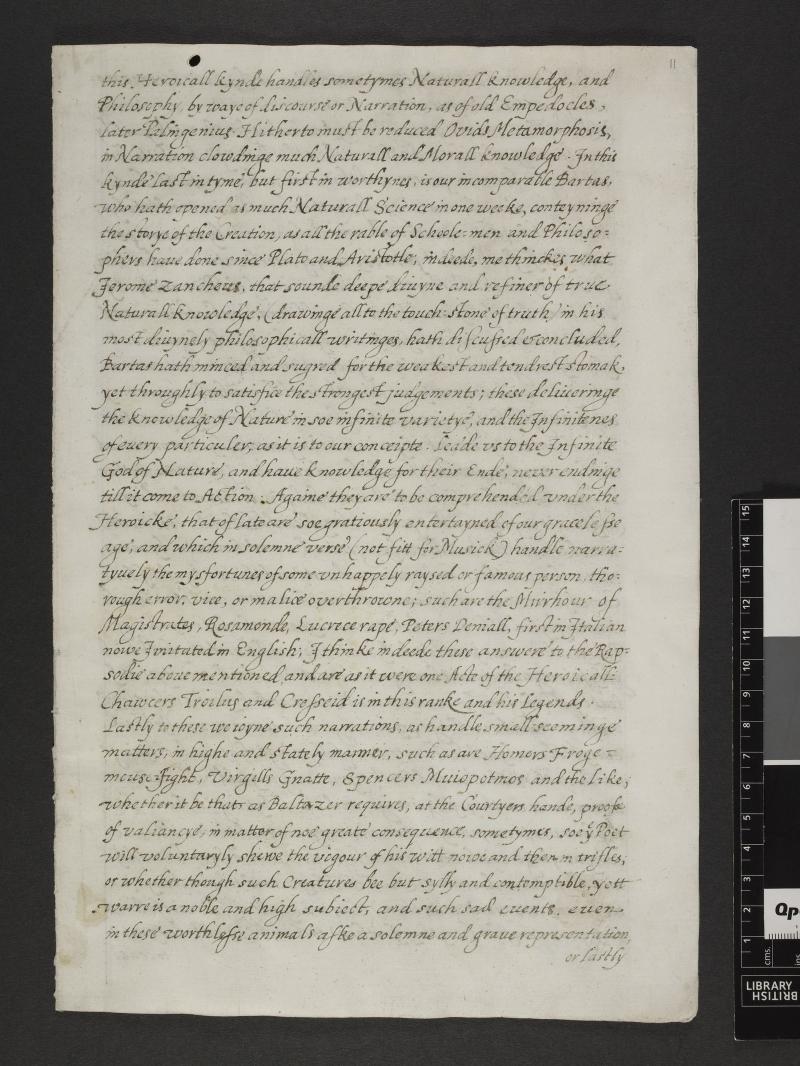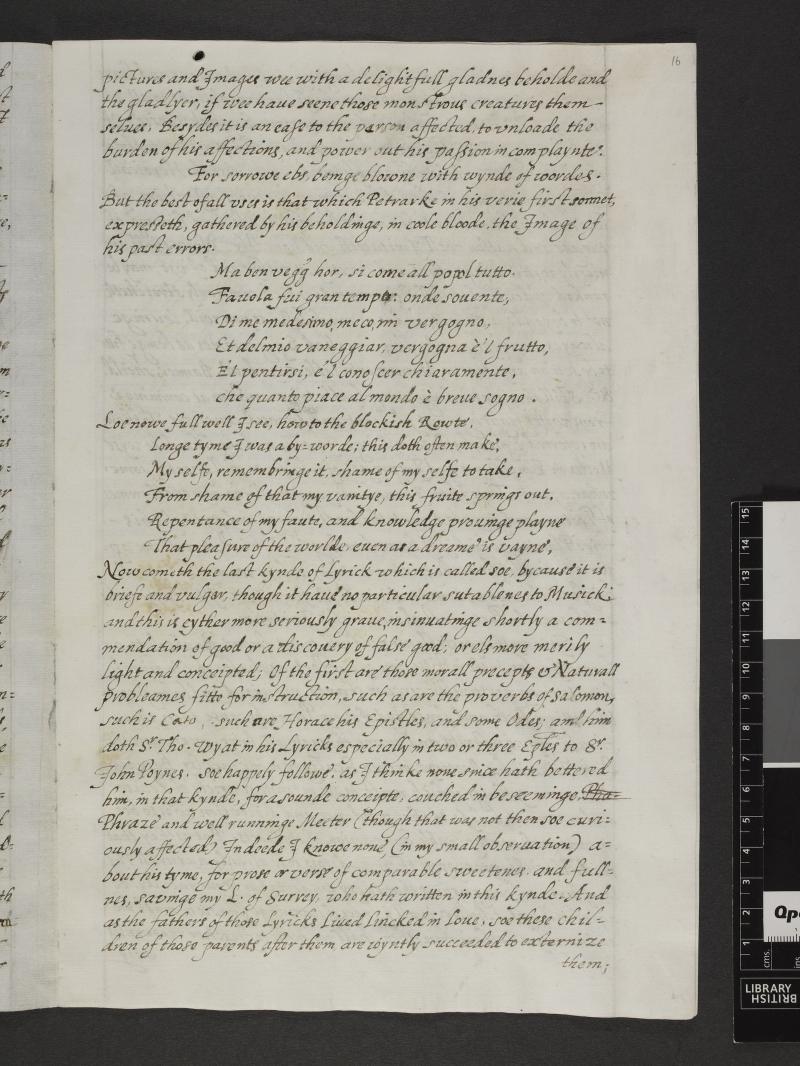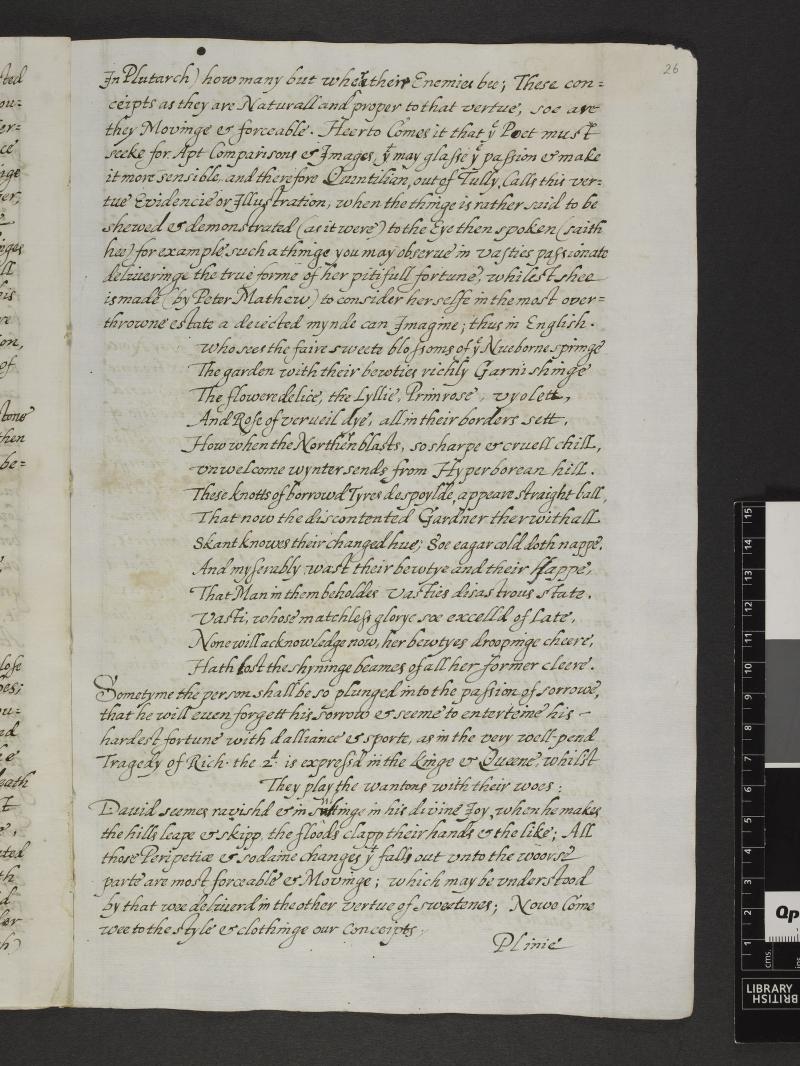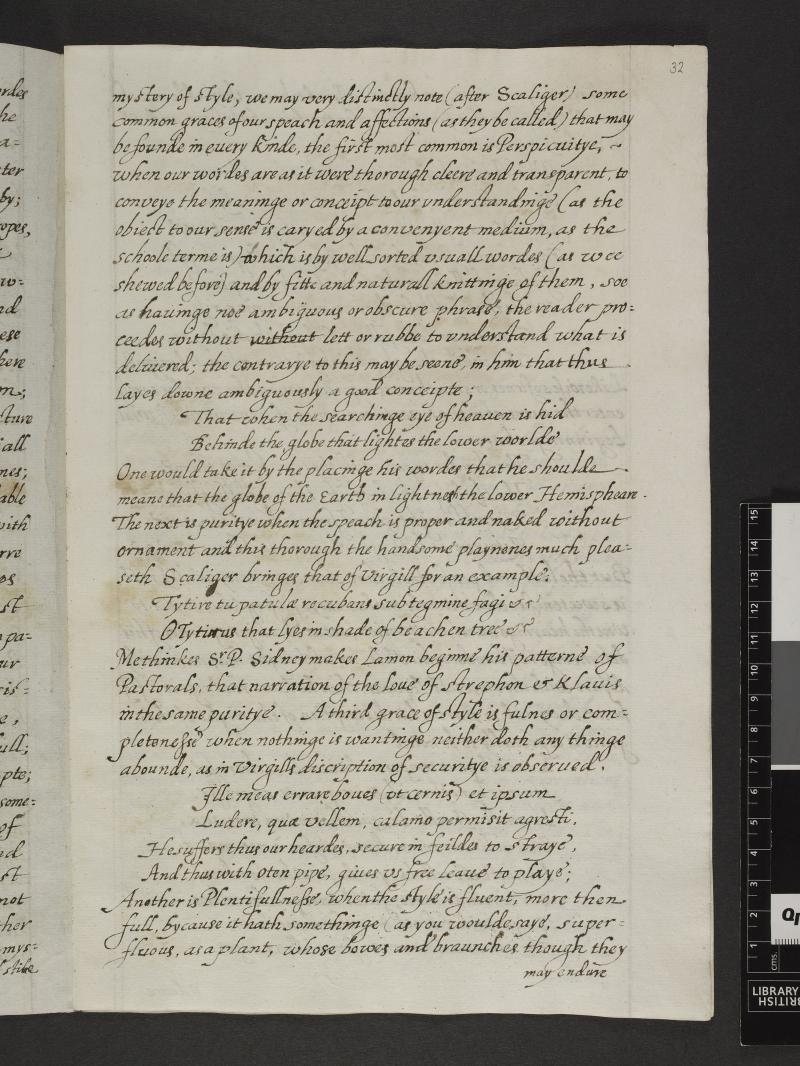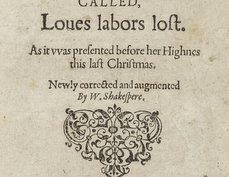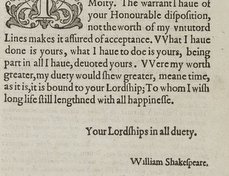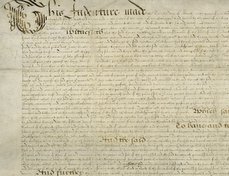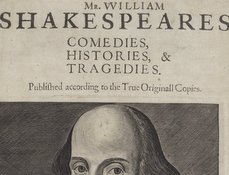From the collections of: THE BRITISH LIBRARY
Terms of use
The British Library has graciously contributed the above images to Shakespeare Documented under a Creative Commons Public Domain Mark.
Copyright status of the Material: The 1988 Copyright, Designs and Patents Act (as amended) states that unpublished literary and artistic works remain in copyright in the UK until at least 31 December 2039. Therefore important parts of the library’s collection remain in copyright, including very old manuscripts. However for unpublished material created many centuries ago and in the public domain in most other countries, the Library believes this material to be very unlikely to offend anyone. As an institution whose role it is to support access to knowledge, we have therefore taken the decision to release certain digitised images technically still in copyright in the UK under the Public Domain Mark.
Document-specific information
Creator: William Scott
Title: The Modell of Poesye Or The Arte of Poesye drawen into a short or Summary Discourse
Date: ca. 1599
Repository: The British Library, London, UK
Call number and opening: Add. MS 81083, fols. 6v, 9v, 11r, 12r, 16r, 26r, 31r, 32r, 39r, 47v
View online bibliographic record
Heather Wolfe, "The Modell of Poesye: Earliest literary criticism of Shakespeare," Shakespeare Documented, https://doi.org/10.37078/116.
British Library, Add MS 81083. See Shakespeare Documented, https://doi.org/10.37078/116.
William Scott’s The Modell of Poesye, a treatise on poetics, includes the earliest literary criticism of Shakespeare. Although Shakespeare is not mentioned by name in the manuscript, two of his works are. When discussing lyrical poetry that expresses emotion, Scott quotes line 1330 of Rape of Lucrece, “For sorrow ebbs, being blown with wind of words” (fol. 16r) as an example of a virtuous aphorism. In another section he quotes line 935 of Lucrece in a less-than-complementary way:
Again, you must not have idle attributes only to fill up your meter (saith Scaliger): "The endless date of neverending woe," a very idle, stuffed verse in that very well-penned poem of Lucrece her rape. (fol. 31r)
He also mentions Lucrece in passing while discussing the Elizabethan short epic, as an example of "solemn verse (not fit for music)" that treats "the misfortunes of some unhappily raised or famous person, through error, vice, or malice, overthrown, such are the Mirror of Magistrates, Rosamond, Lucrece's Rape, Peter's Denial, first in Italian, now imitated in English" (fol. 11r).
Scott alludes to and quotes from Richard II in four places, twice referring to the play by name, but never mentioning its authorship. In a section discussing how one might depict the sorrow of a character, he quotes from Richard II, Act 3, Scene 3, line 169:
Sometime the person shall be so plunged into the passion of sorrow that he will even forget his sorrow and seem to entertain his hardest fortune with dalliance and sport, as in the very well-penned tragedy of Richard the Second is expressed in the King and Queen whilst "They play the wantons with their woes." (fol. 26r)
In a discussion of the representation of pastoral figures in literature, he includes Shakespeare's gardener in Richard II: "The gardener, in like sort, is with a passing good decorum brought on the stage in that well-conceited tragedy of Richard the second" (fol. 12r).
In a section on "perspicuity," that is, "when our words are, as it were, thorough clear and transparent, to convey the meaning or conceit to our understanding," he criticizes an ambiguously worded passage in Richard II, Act 1, scene 2, lines 27-28:
the contrary to this may be seen, in him that thus lays down ambiguously a good conceit--"That when the searching eye of heaven is hid / behind the globe that lights the lower world"--One would take it by the placing his words that he should mean that the globe of the earth enlightens the lower hemisphere.
He cites an extended passage by John of Gaunt in Richard II (act 1, scene 3, lines 232-8) as a good example of describing an emotion in multiple ways to amplify the effect:
Sometimes our amplification is by heaping our words, and as it were piling one phrase upon another of the same sense, to double and redouble our blows, that by varying and reiterating may work into the mind of the reader:
Shorten my days thou canst with sullen sorrow,
And pluck nights from me but not lend a morrow.
Thou canst help time to furrow me with age.
But stop no wrinkle in his pilgrimage;
Thy word is current with him for my death,
But dead, thy kingdom cannot buy my breath. (fol. 39r)
William Scott was born in Kent around 1571, wrote the Model while at the Inner Temple in around 1599, and entered Parliament in 1601, placing him in London while Shakespeare’s plays were being performed. The manuscript is in a scribal hand with some corrections in Scott’s own hand. Scott’s work differs from other works of Elizabethan literary criticism in that he looks not only to classical authors, but to contemporary English writers as well, including Philip Sidney and Edmund Spenser. In his edition of the manuscript, Gavin Alexander notes that while the use of Sidney is not surprising, "that of Shakespeare was unprecedented" (Alexander, lxi).
Scott dedicated his manuscript treatise to Sir Henry Lee, a favorite of Elizabeth I. For over 400 years, it remained in Lee's family, first at Ditchley Park, seat of the Lee and Dillon families, until 1932, and then passed by descent in the family of the Viscounts Dillon. It was acquired by the British Library in 2005 through Maggs.
[fol. 11r]
Again, they are to be comprehended under the Heroic, that of late are so graciously entertained of our graceless age, and which in solemn verse (not fit for music) handle narratively the misfortunes of some unhappily raised or famous person, through error, vice, or malice overthrown. Such are the Mirror of Magistrates, Rosamond, Lucrece's Rape, Peter's Denial, first in Italian, now imitated in English...
[fol. 12r]
These are subdivided as those by shepherds properly called Pastorals, by neatherds or cretekeepers accordingly Bucolics, of husbandry or husbandmen therefore Georgics, goatherd kinds have their name agreeable, or if ought besides, as Sanazar has added those of fishers, out of Theocritus (sayeth Scaliger). Chaucer's Canterbury Tales (for ought I see) are to be quartered with these, and may be named of travelers or pilgrims, for the vulgar persons, and for their manner is much after this. The gardener in like sort, is with a passing good decorum brought on the stage in that well-conceited tragedy of Richard the second.
[fol. 16r]
Besides, it is an ease to the person affected to unload the burden of his affections, and power out his passion in complaint: "For sorrow ebbs, being blown with wind of words."
[fol. 26r]
Sometime the person shall be so plunged into the passion of sorrow that he will even forget his sorrow and seem to entertain his hardest fortune with dalliance and sport, as in the very well-penned tragedy of Richard the Second is expressed in the King and Queen whilst "They play the wantons with their woes."
[fol. 31r]
Homer saith swift-footed Achilles wept; again, you must not have idle attributes only to fill up your meter (saith Scaliger): "The endless date of neverending woe," a very idle, stuffed verse in that very well-penned poem of Lucrece her rape.
[fol. 32r]
... we may very distinctly note (after Scaliger) some common graces of our speech and affections (as they be called) that may be found in every kind. The first most common is Perspicuity, when our words are, as it were, thorough clear and transparent, to convey the meaning or conceit to our understanding (as the object to our sense is carried by a convenient medium, as the school term is), which is by well sorted usual words (as we showed before) and by fit and natural knitting of them, so as having no ambiguous or obscure phrase, the reader proceeds without let or rub to understand what is delivered. The contrary to this may be seen, in him that thus lays down ambiguously a good conceit--"That when the searching eye of heaven is hid / behind the globe that lights the lower world"--One would take it by the placing his words that he should mean that the globe of the earth enlightens the lower hemisphere.
[fol. 39r]
Sometimes our amplification is by heaping our words, and as it were piling one phrase upon another of the same sense, to double and redouble our blows, that by varying and reiterating may work into the mind of the reader:
Shorten my days thou canst with sullen sorrow,
And pluck nights from me but not lend a morrow.
Thou canst help time to furrow me with age.
But stop no wrinkle in his pilgrimage;
Thy word is current with him for my death,
But dead, they kingdom cannot buy my breath.
[fol. 11r]
... Againe they are to be comprehended vnder the
Heroicke, that of late are soe gratiously entertayned of our gracelesse
age, and which in solemne verse (not fitt for Musick) handle narra=
tyuely the mysfortunes of some vnhappely raysed or famous person, tho=
rough error, vice, or malice overthrowne; such are the Mirrhour of
Magistrates, Rosamonde, Lucrece rape, Peters Deniall, first in Italian
nowe Imitated in English
[fol. 12r]
... Thes are sub=
diuided as those by sheepheards properly called Pastoralls, by Neate=
heards or Cretekeepers accordingly Bucolicks, of husbandry or hus=
bandmen therefore Georgicks; Goteheard kyndes haue their name
agreeable, or if ought besydes, as Sanazarr hath added those of fish=
ers, out of Theocritus (sayeth Scaliger): Chawcers Canterbury tales
(for ought I see) are to be quartered with these, and may be named of
trauaylers or pylgrimes, for the vulgar persons, and for their man=
ner is much after this. The gardner in like sorte, is with a passinge
good Decorum brought on the stage in that well-conceipted Tragedye
of Richard the seconde./
[fol. 16r]
Besydes it is an ease to the person affected, to vnloade the
burden of his affections, and power out his passion in complaynte:
For sorrowe ebs, beinge blowne with wynde of woordes.
[fol. 26r]
Sometyme the person shall be so plunged into the passion of sorrowe,
that he will euen forgett his sorrow & seeme to enterteine his
hardest fortune with dalliance & sporte, as in the very well-pend
Tragedy of Rich. the 2d is express'd in the Kinge & Queene, whilst
They play the wantons with their woes
[fol. 31r]
Homer sayth swifte footed Achilles wept, againe you
must not haue Idle attributes onely to fill vp your meeter (sayth
Scaliger) The eandlesse date of Neuer endinge woe, a very Idle ^stuffed verse
in that very well penned Poeme of Lucrece her rape.
[fol. 32r]
We may very distinctly note (after Scaliger) some
common graces of our speach and affections (as they be called) that may
be founde in euery kinde, the first most common is Perspicuitye,
when our wordes are as it were thorough cleere and transparent, to
conveye the meaninge or conceipt to our vnderstandinge (as the
obiect to our sense is caryed by a convenyent medium, as the
schoole terme is) which is by well sorted vsuall wordes (as wee
shewed before) and by fitte and naturall knittinge of them, soe
as hauinge noe ambiguous or obscure phrase, the reader pro=
ceedes without without lett or rubbe to vnderstand what is
deliuered; the contrarye to this may be seene, in him that thus
layes downe ambiguously a good conceipte;
That when the searchinge eye of heauen is hid
Behind the globe that lightes the lower worlde
One would take it by the placinge his words that he shoulde
meane that the globe of the Earth in lightneth the lower Hemispheare.
Sometyme our amplification is by heapinge our
wordes, and as it were pilinge one phraze vpon an other of
the same sense, to double and redouble our blowes that by va=
ryinge and reiteratinge may worke into the mynde of the
reader
Shorten my dayes thou canst with sullen sorrowe,
And plucke nightes from me but not lende me amorowe.
Thou canst helpe tyme to furrowe me with age.
But stoppe noe wrinckle in his pilgrimage;
Thy worde is currant with him for my death,
But deade, thy kingedome cannot buy my breath.
Written by Heather Wolfe
Sources
Gavin Alexander, ed., William Scott, The Model of Poesy (Cambridge: Cambridge University Press, 2013).
Last updated June 10, 2020

